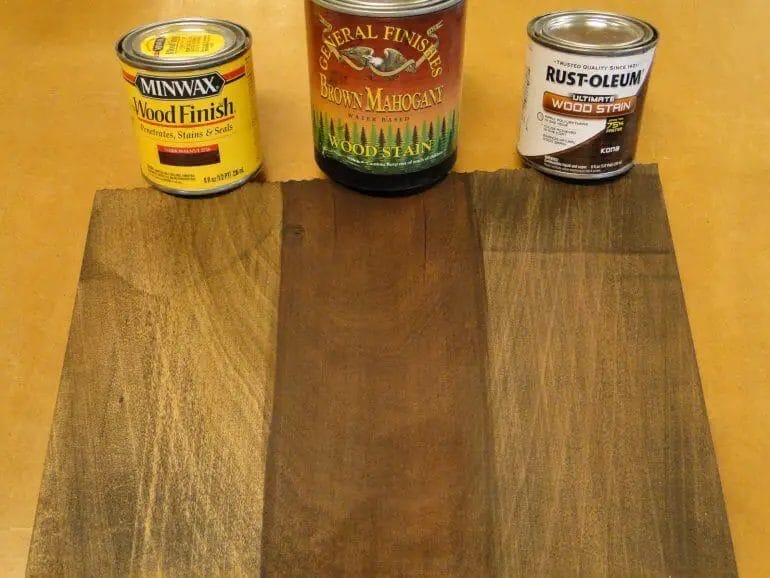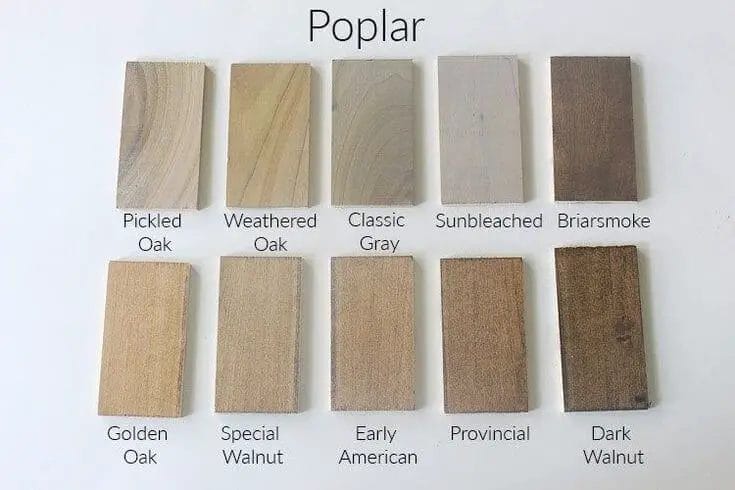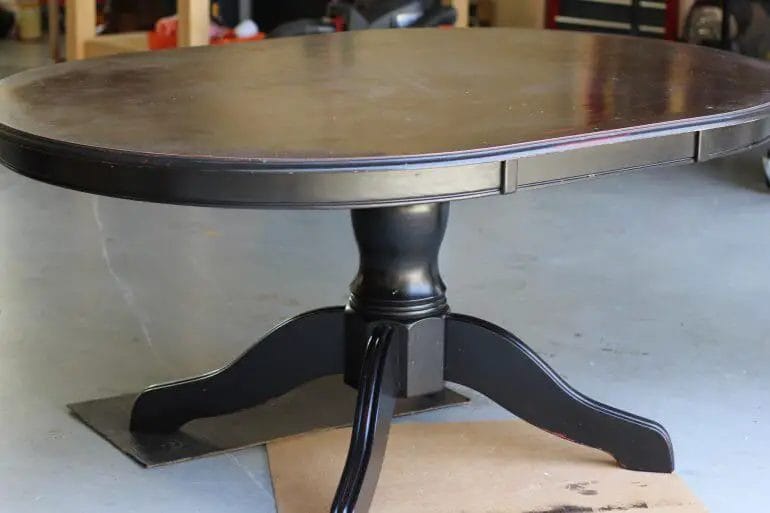Want to give your poplar wood a stunning and rich finish? Look no further! In this guide, we’ll show you how to stain poplar wood like a pro.
Staining poplar wood is a great way to enhance its natural beauty, add depth, and bring out its unique grain patterns. Whether you’re working on a DIY project or a professional woodworking endeavor, our step-by-step instructions will help you achieve professional-looking results.

First, it’s essential to prepare the surface by sanding the poplar wood to create a smooth and even finish. Use fine-grit sandpaper and work in the direction of the wood grain. This allows the stain to penetrate the wood evenly and ensures a uniform appearance.
After sanding, thoroughly clean the wood surface to remove any dust, dirt, or debris. This step is crucial to achieving a flawless finish. Use a tack cloth or a soft brush to gently remove any particles that may have settled on the wood.
Next, apply a wood conditioner to the poplar wood. This helps the stain to apply more evenly and prevents blotching. Follow the manufacturer’s instructions for the specific wood conditioner you’re using, and allow it to dry completely before moving on to the staining process.
Now it’s time to apply the stain. Use a brush, sponge, or cloth to apply the stain in smooth, even strokes, working in the direction

Tips for Preparing Poplar Wood for Staining
If you are planning to stain poplar wood, it is important to properly prepare the surface to ensure a smooth and even finish. Poplar wood is known for its tight grain and tendency to absorb stain unevenly, so following the right preparation steps is crucial. In this section, we will discuss some essential tips to help you achieve the best results when staining poplar wood.
Clean the Surface
Before you start staining, it is important to clean the surface of the poplar wood. Remove any dust, dirt, or debris using a clean, dry cloth or a vacuum cleaner with a brush attachment. Cleaning the surface will ensure that the stain adheres properly and provides an even finish.
Sand the Wood
Sanding the poplar wood is a vital step in the preparation process. Since poplar wood has a tight grain, sanding helps to open up the pores and create a more receptive surface for the stain. Start by using coarse-grit sandpaper and then gradually move to finer grits. Sand in the direction of the wood grain to prevent scratches. Be thorough and make sure to sand all areas, including edges and corners.
Fill the Grain (Optional)
If you want to achieve an even smoother finish, you may consider filling the grain of the poplar wood. This step is optional, but it can help minimize the grain’s appearance and create a more uniform look. There are wood grain fillers available in the market that you can use to fill the pores. Apply the filler according to the manufacturer’s instructions and allow it to dry completely before proceeding to the next step.
Apply Pre-Stain Conditioner
Since poplar wood tends to absorb stain unevenly, it is highly recommended to apply a pre-stain conditioner. This conditioner helps to seal the wood and create a more uniform surface for the stain. Follow the instructions on the product and apply the conditioner evenly using a brush or cloth. Allow the conditioner to penetrate the wood for the recommended time before applying the stain.
Choose the Right Stain
When selecting a stain for poplar wood, consider choosing a pigment-based stain rather than a dye-based one. Pigment-based stains tend to provide a more even color and help minimize the uneven absorption of the wood. Test the stain on a small, inconspicuous area of the poplar wood to ensure it matches your desired color.
Apply the Stain
Once the wood is properly prepared, it’s time to apply the stain. Stir the stain thoroughly before use to ensure an even distribution of the pigments. Use a brush, foam applicator, or cloth to apply the stain in the direction of the wood grain. Work in small sections and make sure to keep a wet edge to avoid lap marks. Allow the stain to penetrate the wood for the recommended time and then wipe off any excess with a clean cloth.
Seal the Wood
After the stain has dried completely, it is important to seal the poplar wood to protect the finish and enhance its durability. Choose a clear topcoat, such as polyurethane or varnish, and follow the manufacturer’s instructions for application. Apply multiple coats if necessary, allowing proper drying time between each coat.
Final Thoughts
Preparing poplar wood for staining requires attention to detail and careful execution. By following these tips, you can ensure that your poplar wood project achieves a beautiful and professional-looking finish. Remember to clean the surface, sand the wood, and consider optional steps like filling the grain or applying a pre-stain conditioner. Choose the right stain and seal the wood properly to protect and enhance the final result. With proper preparation, your poplar wood will be ready to showcase its natural beauty with a flawless stain.

Step-by-Step Guide to Staining Poplar Wood
If you’re looking to enhance the beauty and durability of your poplar wood furniture or project, staining is a great option. Staining poplar wood not only adds color and richness to the surface but also helps protect it from moisture and UV damage. In this section, we will provide you with a step-by-step guide to staining poplar wood, ensuring that you achieve professional-looking results.
1. Prepare the Surface
The first step in staining poplar wood is to properly prepare the surface. Start by sanding the wood with a fine-grit sandpaper to create a smooth and even surface. This will help the stain adhere better and ensure a more uniform finish. After sanding, remove any dust or debris using a tack cloth or a vacuum cleaner.
2. Choose the Right Stain
Next, it’s important to choose the right stain for your poplar wood. There are various types of wood stains available, including oil-based stains, water-based stains, and gel stains. Consider the color and transparency you desire, as well as the overall look you want to achieve. Test the stain on a small, inconspicuous area of the wood to ensure it matches your expectations.
3. Apply the Stain
Before applying the stain, make sure to wear protective gloves and work in a well-ventilated area. Stir the stain thoroughly to ensure an even color distribution. Using a clean brush or a cloth, apply a thin and even coat of stain in the direction of the wood grain. Allow the stain to penetrate the wood for the recommended amount of time specified by the manufacturer.
4. Remove Excess Stain
After the recommended time has elapsed, carefully wipe off any excess stain using a clean cloth. Make sure to remove all excess stain to avoid uneven drying and potential color variations. Take your time and be thorough in this step to achieve a professional-looking finish.
5. Allow the Stain to Dry
Allow the stained poplar wood to dry completely before applying any further coats or finishes. Drying times can vary depending on the type of stain and environmental conditions. Follow the manufacturer’s instructions for specific drying times. It’s essential to ensure the wood is completely dry before moving on to the next step.
6. Apply a Clear Finish
Once the stain has dried, you may choose to apply a clear finish to further protect and enhance the wood’s appearance. Select a finish that is compatible with your chosen stain and follow the manufacturer’s instructions for application. Apply thin and even coats, allowing proper drying time between each coat.
7. Final Touches
After the clear finish has dried, give your stained poplar wood a final inspection. Look for any areas that may need additional touch-ups or refinishing. If necessary, lightly sand the surface and reapply stain or clear finish to achieve the desired result.
Summary
Staining poplar wood is a rewarding way to enhance its natural beauty and protect it from everyday wear and tear. By following this step-by-step guide, you can achieve professional-looking results and ensure your poplar wood projects stand out. Remember to properly prepare the surface, choose the right stain, apply it evenly, remove excess stain, allow it to dry, and consider applying a clear finish for added protection.

Common Mistakes to Avoid When Staining Poplar Wood
Staining poplar wood can be a great way to enhance its natural beauty and give it a richer, more luxurious look. However, there are some common mistakes that people often make when staining poplar wood. By avoiding these mistakes, you can ensure that your staining project is successful and your poplar wood looks its best.
Choosing the Wrong Stain
One of the most common mistakes people make when staining poplar wood is choosing the wrong type of stain. It’s important to select a stain that is specifically designed for use on poplar wood. Poplar is a relatively soft wood that can absorb stain unevenly if the wrong type of stain is used. Look for a stain that is formulated for use on softwoods and follow the manufacturer’s instructions for best results.
Failing to Prepare the Wood
Another mistake to avoid is failing to properly prepare the poplar wood before staining. This includes cleaning the wood to remove any dirt, dust, or grease that may be present. It’s also important to sand the wood to create a smooth surface and remove any imperfections. Skipping this step can result in a poor finish and uneven stain absorption.
Not Testing the Stain
Before applying the stain to the entire piece of poplar wood, it’s important to test it in a small, inconspicuous area. This will allow you to see how the stain will look on the wood and make any necessary adjustments. Failure to test the stain can lead to unexpected results and potential disappointment with the final outcome.
Applying Too Much Stain
Applying too much stain to poplar wood is another common mistake. It’s important to apply the stain in thin, even coats and allow each coat to dry completely before applying the next. Applying too much stain can result in blotchy, uneven coloring and can make the wood look unnatural. Take your time and apply the stain carefully for the best results.
Not Using a Sealant
After staining poplar wood, it’s important to protect the finish by applying a sealant. The sealant will help to prevent the stain from fading or wearing off over time and will provide added durability to the wood. Be sure to choose a sealant that is compatible with the type of stain you used and follow the manufacturer’s instructions for application.
Skipping the Finishing Touches
Finally, don’t forget the finishing touches when staining poplar wood. This includes things like sanding between coats of stain and sealant for a smooth, professional finish. Additionally, consider using a topcoat or wax to further enhance the beauty and protect the wood. These small details can make a big difference in the final appearance of your stained poplar wood.
Summary
When staining poplar wood, it’s important to avoid common mistakes that can result in an unsatisfactory finish. Choose the right stain for poplar wood, properly prepare the wood, test the stain, apply it in thin coats, use a sealant, and pay attention to the finishing touches. By following these tips, you can achieve a beautiful, professional-looking finish on your poplar wood projects.
How to Achieve a Professional Finish on Poplar Wood
Poplar wood is a popular choice among woodworkers due to its affordability and versatility. However, achieving a professional finish on poplar wood can be a bit challenging if you don’t know the right techniques. In this section, we will discuss some tips and tricks that will help you achieve a smooth and professional finish on your poplar wood projects.
1. Proper Sanding
The key to achieving a professional finish on poplar wood is proper sanding. Start by using a coarse-grit sandpaper (around 80-100 grit) to remove any rough spots or imperfections on the surface of the wood. Gradually work your way up to a finer-grit sandpaper (around 180-220 grit) to smooth out the surface even further. Be sure to sand with the grain of the wood to avoid any scratches.
After sanding, use a tack cloth to remove any dust or debris from the surface of the wood. This will ensure a clean and smooth surface for applying the finish.
2. Choose the Right Finish
There are various types of finishes available for poplar wood, including stains, paints, and clear coats. The choice of finish will depend on your desired look and the project you are working on.
If you want to enhance the natural beauty of the wood, you can use a stain. Make sure to test the stain on a small, inconspicuous area of the wood to ensure the desired color. Apply the stain evenly and wipe off any excess with a clean cloth. Allow the stain to dry completely before applying any sealant or topcoat.
If you prefer a painted finish, make sure to prime the wood first to ensure better adhesion and durability. Use a brush or a sprayer to apply the paint evenly, and let it dry between coats for a smooth and even finish.
For a clear and glossy finish, consider using a polyurethane or lacquer. These finishes provide a protective layer and can enhance the appearance of the wood grain. Apply the finish in thin, even coats, following the manufacturer’s instructions.
3. Apply a Sealant
Applying a sealant is an important step in achieving a professional finish on poplar wood. A sealant helps to protect the wood from moisture, stains, and scratches, ensuring its longevity.
You can choose from a variety of sealants, such as varnish, shellac, or polyurethane. Apply the sealant evenly with a brush or cloth, following the direction of the wood grain. Allow it to dry completely before applying additional coats if necessary.
4. Sand Between Coats
If you are applying multiple coats of finish or sealant, it is crucial to sand between each coat. This will help create a smooth and seamless finish. Use a fine-grit sandpaper (around 220-320 grit) to lightly sand the surface, then remove any dust before applying the next coat.
5. Final Touches
Once you have applied all the necessary coats of finish and allowed them to dry, it’s time to add the final touches. Lightly sand the surface with a very fine-grit sandpaper (around 400-600 grit) to remove any imperfections or rough spots. Wipe the surface clean with a tack cloth, and your poplar wood project is ready for display or use.
In summary, achieving a professional finish on poplar wood requires proper sanding, choosing the right finish, applying a sealant, sanding between coats, and adding final touches. By following these steps and techniques, you can transform your poplar wood projects into beautifully finished pieces that will impress others with their smooth and professional appearance.
FAQs
Q: How to stain poplar wood?
To stain poplar wood, start by sanding the wood surface to remove any imperfections. Apply a pre-stain conditioner to even out the stain absorption. Then, apply the wood stain using a brush or cloth, following the wood grain. Wipe off any excess stain and allow it to dry. Finish by applying a clear topcoat for protection and a smooth finish.
Q: Can you stain poplar wood without sanding?
While sanding is recommended to achieve a smooth finish, you can still stain poplar wood without sanding. However, the stain may not penetrate the wood as well, resulting in a less uniform color and finish. Sanding helps to open up the wood pores, allowing the stain to absorb more evenly.
Q: What type of stain is best for poplar wood?
Oil-based stains are commonly used for poplar wood as they provide rich, even color penetration. However, water-based stains are also suitable for poplar wood and offer faster drying times with low odor. Choose a stain that complements your desired finish and follow the manufacturer’s instructions for best results.
Conclusion
In conclusion, staining poplar wood can be a straightforward process when following the right steps. By properly preparing the wood, choosing the right stain, and applying it correctly, you can achieve beautiful results that enhance the natural grain and color of poplar wood.
Remember to start with a thorough sanding to ensure a smooth surface before applying the stain. Additionally, test the stain on a small area or scrap piece of poplar to ensure it achieves the desired color. Once you are ready to apply the stain, use a brush or cloth to evenly distribute it along the grain, wiping off any excess.
Overall, staining poplar wood allows you to personalize and enhance its appearance to suit your specific style and preferences. With patience and attention to detail, you can transform poplar wood into a stunning and durable piece of furniture or decorative element.